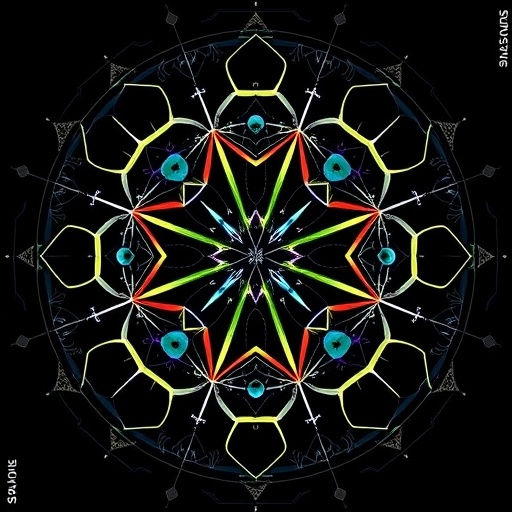
A groundbreaking study unveils the enigmatic features of dogroses, a group of pentaploid plants distinguished by their unique genomic architecture and a century-old mystery surrounding their meiosis. By employing cutting-edge genome assembly techniques, researchers have decoded the complex subgenomes and centromeres of dogroses, shedding new light on how these enigmatic plants manage their reproduction in extraordinary ways.
Dogroses, particularly those from the subsections Caninae and Rubigineae, exhibit a remarkable meiotic mechanism involving both bivalent and univalent chromosome behavior. This distinct reproductive strategy, known as Canina meiosis, has puzzled botanists for decades. The recent study integrates structural genome analysis with pollen-based genomics and hybridization experiments, revealing that the bivalent-forming subgenomes evolved independently and display differing interaction dynamics during meiosis.
Central to this discovery is the bimodal architecture of dogrose centromeres. The research highlights that centromeres belonging to bivalent-forming subgenomes (S1 in Caninae and R4 in Rubigineae) are dominated by ATHILA long terminal repeats (LTRs), while the centromeres of the permanently univalent subgenomes (S2 and R3) are enriched with CANR4 repeats. This divergence in centromeric DNA composition appears to govern their meiotic behavior, particularly influencing their pairing and transmission during gametogenesis.
.adsslot_NC89ekDztH{width:728px !important;height:90px !important;}
@media(max-width:1199px){ .adsslot_NC89ekDztH{width:468px !important;height:60px !important;}
}
@media(max-width:767px){ .adsslot_NC89ekDztH{width:320px !important;height:50px !important;}
}
ADVERTISEMENT
This centromere composition is especially crucial in female meiosis, where univalent chromosomes are obligatorily transmitted through the egg cell. The expansion of CANR4 repeats within univalent centromeres is proposed as a mechanism facilitating centromere “drive,” a phenomenon where larger centromeres are preferentially inherited during asymmetric female meiosis. This drive enforces the maintenance of the pentaploid genome by ensuring univalents’ preferential passage through the female germline, representing a compelling example of genome evolution shaped by meiotic constraints.
Interestingly, the presence of ATHILA-based centromeres in some univalent chromosomes indicates that CANR4 expansion alone cannot fully explain this drive mechanism. Moreover, the structural divergence of centromeres also seems to influence male meiosis. In male meiosis, univalents with large CANR4-enriched centromeres may undergo bipolar orientation and premature sister chromatid separation—a phenomenon contrasting sharply with the largely monopolar orientation of univalents observed during female meiosis in dogroses.
The underlying molecular regulation likely involves sexual dimorphism in sister chromatid cohesion, a hypothesis supported by parallels in other plant species. For example, in Arabidopsis thaliana, bipolar orientation of univalents occurs solely under defective cohesion conditions, whereas in wheat, it is more prevalent. These varied behaviors emphasize the specialized adaptations of dogroses, enabling their unique Canina meiosis to persist.
Further insights propose that the competitive environment created by homologous chromosome pairs limits CANR4 expansion in bivalent-forming subgenomes. In contrast, the absence of homologues in univalent chromosomes enables CANR4 repeats to accumulate. This model is bolstered by the lack of CANR4-based centromeres in diploid rose species such as Rosa chinensis and Rosa rugosa, pinpointing the evolution of centromeric repeats to the polyploid dogrose lineages.
Beyond simple repeat accumulation, the study reveals the emergence of tandem repeats originating from LTR sequences within some univalent R4 chromosomes, which gain an affinity for centromere-specific histone CENH3 over nearby ATHILA elements. This competitive advantage highlights the dynamic and adaptive nature of centromere composition in shaping chromosomal behavior during meiosis.
Remarkably, despite the absence of recombination in univalent chromosomes, these chromosomes retain a high completeness of protein-coding genes, indicating that the genetic integrity of univalents remains intact. This gene functionality implies a relatively recent evolutionary origin for modern dogroses and underscores the robustness of their polyploid genomes in managing atypical reproductive strategies.
Phylogenetic analyses employing both nuclear and plastid markers corroborate the polyphyletic origins of dogroses, unveiling a complex history shaped by multiple hybridization events. The distinct subgenomic ratios between species such as Rosa canina and Rosa agrestis highlight the evolutionary intricacies of their hybrid genomes, mixing subgenomes from the Synstylae and Rosa clades in varying proportions.
Additionally, pollen single-copy ortholog data aligns well with cytogenetic findings, reinforcing the phylogenetic distance between the bivalent-forming subgenomes of subsections Caninae and Rubigineae. The occurrence of multiple genetic lineages within the S1 and S2 subgenomes of Rosa canina indicates multiple origins, supporting a model where complex hybridization and polyploidization drive the evolutionary trajectory of dogroses.
This wealth of data sheds light not only on the origin but also on the evolutionary maintenance of Canina meiosis—an exceptional mechanism where distinct subgenomes follow specialized meiotic pathways within a single organism. The interplay between centromere structure, chromosome pairing behavior, and genome transmission strategies provides a fascinating example of how plants can navigate the challenges of polyploidy and reproduction.
Future research is anticipated to delve deeper into the molecular interactions that govern centromere-based drive and sister chromatid cohesion differences. Such studies may unravel the precise genetic and epigenetic controls enabling this peculiar meiotic mode, potentially illuminating new aspects of chromosome biology that transcend plant systems.
Ultimately, this study unravels one of the enduring mysteries of plant genetics, demonstrating how structural genome variation intersects with reproductive innovation to create complex life cycles. The detailed characterization of dogrose centromeres and subgenomes not only advances our understanding of meiosis but also raises profound questions about genome evolution under selective reproductive pressures.
By mapping the genomic and cytogenetic landscapes of pentaploid dogroses, researchers have charted a path forward to comprehend the intricate balance between chromosome dynamics and evolutionary success. The implications of these findings extend beyond botany, offering a window into the forces that shape genomes in diverse eukaryotic systems and emphasizing the power of integrative genomics in solving biological enigmas.
Article Title:
Bimodal centromeres in pentaploid dogroses shed light on their unique meiosis.
Article References:
Herklotz, V., Zhang, M., Nascimento, T. et al. Bimodal centromeres in pentaploid dogroses shed light on their unique meiosis. Nature (2025). https://doi.org/10.1038/s41586-025-09171-z
Tags: ATHILA long terminal repeatsbimodal centromeres in dogrosesCanina meiosis mechanismscentromeric DNA compositionevolutionary dynamics of dogrose subgenomesgametogenesis in pentaploid speciesgenomic architecture of dogroseshybridization experiments in botanymeiotic behavior of univalent chromosomespentaploid plant reproductionpollen-based genomic studiesstructural genome analysis techniques





